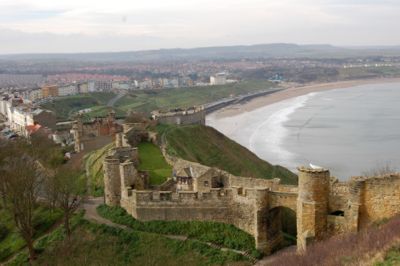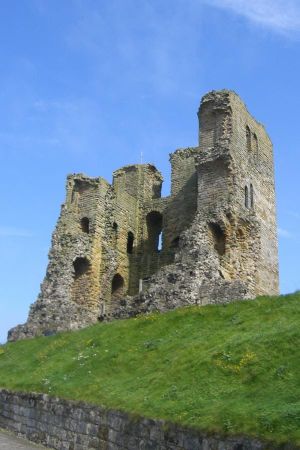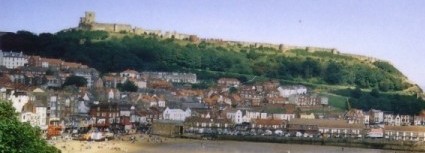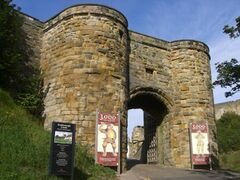Scarborough Castle: Difference between revisions
imported>John Stephenson (→Features: unnecessary unofficial ref) |
imported>John Stephenson (→Early history of the site: unnecessary unofficial ref) |
||
| Line 17: | Line 17: | ||
===Early history of the site=== | ===Early history of the site=== | ||
There is some evidence of [[Iron Age]] and later settlements from around 900-500 BC,<ref>Walmsley (1998: 3) | There is some evidence of [[Iron Age]] and later settlements from around 900-500 BC,<ref>Walmsley (1998: 3).</ref> possibly suggesting something as extensive as a full hill fort on the headland, though evidence of this is yet to be found.<ref>Scarborough Archaeological and Historical Society (2003: 7, 13). The Society speculates that this structure, if it indeed existed, might have been the "hill-fort bay" mentioned by [[Ptolemy]] (c.90-168 AD), the Greco-Roman [[geography|geographer]] (p.13).</ref> Among various finds dating back 2,500 years, a [[Bronze Age]] [[sword]] is on display in the castle exhibition; this is thought to have been a [[ritual]] offering.<ref>''English Heritage'': '[http://www.english-heritage.org.uk/server/show/nav.17274 Scarborough Castle - Background Information]'.</ref> The sword was discovered in 1980 at the castle and forms the centrepiece of English Heritage's £250,000 investment in making the site a strong [[tourism|tourist]] attraction.<ref>''[[Yorkshire Evening Post]]'': '[http://www.yorkshireeveningpost.co.uk/ViewArticle.aspx?SectionID=39&ArticleID=1022895 A gift to the gods... and a godsend for museum]'. 11th May 2005.</ref> | ||
Prior to the establishment of the castle in the [[twelfth century]], a [[fourth century]] [[Ancient Romans|Roman]] signal station stood on the site at the cliff edge to warn of approaching hostile vessels, which took advantage of a natural source of fresh [[water]] that later became known as the 'Well of Our Lady'.<ref>Binns (2002: 17).</ref> However, there is very little to show that the Roman presence at the headland was anything other than a small company; some [[pottery]] has been discovered, but nothing to suggest extensive fortification between the possible Iron Age fort and the much later mediaeval castle.<ref>Scarborough Archaeological and Historical Society (2003: 12, 14).</ref> | Prior to the establishment of the castle in the [[twelfth century]], a [[fourth century]] [[Ancient Romans|Roman]] signal station stood on the site at the cliff edge to warn of approaching hostile vessels, which took advantage of a natural source of fresh [[water]] that later became known as the 'Well of Our Lady'.<ref>Binns (2002: 17).</ref> However, there is very little to show that the Roman presence at the headland was anything other than a small company; some [[pottery]] has been discovered, but nothing to suggest extensive fortification between the possible Iron Age fort and the much later mediaeval castle.<ref>Scarborough Archaeological and Historical Society (2003: 12, 14).</ref> | ||
Revision as of 00:12, 16 May 2009
Scarborough Castle stands on a cliff top overlooking the town of Scarborough, North Yorkshire, in England. The earliest castle fortifications on the site were built in the 1130s, and over the centuries several other structures were added. Today, the castle is a ruin, but still attracts many visitors to climb the battlements, take in the views and enjoy the accompanying interactive exhibition run by English Heritage.
Features

Because the castle sits atop a sheer cliff 300 feet (92 metres) high, only the south-western slopes leading up to the entrance needed to be defended; the outer thirteenth century curtain walls with their eleven hollow towers for archers[1] therefore do not completely surround the inner buildings of the castle. Even today, the castle is sometimes closed to visitors due to high winds.[2] The entranceway consists of a barbican, or fortified gateway, completed in the fourteenth century and flanked by two half-circular towers.[3]
The main building is the 86-feet-tall (26 metres) twelfth century keep, with its entrance on the first floor (i.e. the second level from the ground). Only the shell of the building has survived to this day, with the west wall missing thanks to a seventeenth century bombardment; with its roof it would have been over 100 feet tall (31 metres). The keep and the castle's 150-feet-deep (46 metres) well occupy the inner bailey (courtyard), with other remains in the outer bailey, including two chapels and the 'King's Chambers'. Unusually, the entrance leads first to the inner bailey, which would have been used for workshops, offices, a kitchen, and storage area, then the outer bailey is reached from these. Here entertaining spectacles would have been staged, vegetables grown and animals kept. The baileys are separated by a wall, ditch and bank, with two defended gateways. A second mediaeval hall was built to accommodate royal visitors, with several rooms for preparing and storing food, or private chambers.[4]
The King's Chambers, also known as Mosdale Hall after a fourteenth century governor of the castle, are a striking example of how the castle has been much-altered over the years. Originally built in the thirteenth century, it was converted to a red-brick barracks building in the eighteenth century; this is clearly visible along the much earlier stone wall, facing Scarborough's South Bay. The castle itself is a replacement for a twelfth century fortification, which in turn was built over the old eleventh century Anglo-Saxon chapel. The thirteenth century Queen's Tower in the wall near Mosdale Hall also saw different uses: initially luxurious accommodation with private latrines and large windows with bay views, two of these windows were later blocked up, and another changed to a cupboard with a rubbish chute.[5]
More recently, the eighteenth century Master Gunner's House now serves as a museum including an interactive exhibition whose centrepiece is the Bronze Age sword. The castle site, managed by English Heritage since 1984, is host to various events, usually in summertime, such as pirate and Robin Hood-themed activities.[6] Needless to say, the castle grounds are also reputed to be haunted - by three ghosts, among them a Roman soldier at the signal station site.[7]
History
The castle's ten centuries of history have seen it move from a major fortification in the Middle Ages to a well-loved ruin today. It played an important role in several major English events, and survived a series of major sieges as its ownership passed between rival forces; its loyalty to the Crown would ultimately lead to its destruction. The site itself was far from barren before the establishment of the castle, having hosted activities dating back thousands of years.
Early history of the site
There is some evidence of Iron Age and later settlements from around 900-500 BC,[8] possibly suggesting something as extensive as a full hill fort on the headland, though evidence of this is yet to be found.[9] Among various finds dating back 2,500 years, a Bronze Age sword is on display in the castle exhibition; this is thought to have been a ritual offering.[10] The sword was discovered in 1980 at the castle and forms the centrepiece of English Heritage's £250,000 investment in making the site a strong tourist attraction.[11]
Prior to the establishment of the castle in the twelfth century, a fourth century Roman signal station stood on the site at the cliff edge to warn of approaching hostile vessels, which took advantage of a natural source of fresh water that later became known as the 'Well of Our Lady'.[12] However, there is very little to show that the Roman presence at the headland was anything other than a small company; some pottery has been discovered, but nothing to suggest extensive fortification between the possible Iron Age fort and the much later mediaeval castle.[13]
The Anglo-Saxons built a chapel on the station site around the year 1000; its remains are still visible.[14] This is said to have been destroyed by William the Conqueror's ally Harald Hardrada in 1066[15] - a later Icelandic poem[16] claims that an early Viking settlement around the harbour was burnt down in 1066 by Hardrada's forces, who reputedly built a large bonfire on the headland to supply burning brands to hurl at the villagers below.[17] This fate of the settlement, if it existed at all, is supported by the fact that Scarborough is not mentioned in the Domesday Book (a survey or census of eleventh century England). However, there is no archaeological evidence of such an inferno, nor any of the Viking presence; the first clear evidence of the earliest town coincides with the establishment of the surviving stone castle a century later, around 1163, following the development of a small settlement around the original castle.[18]
The original castle, 1138-1157
The current ruins of Scarborough Castle were not the first attempt to establish a fortification on the headland. First to indisputably do so was William le Gros, Count of Aumale ('the Fat', died 1179), grand-nephew of William the Conqueror. A powerful Anglo-Norman baron, William le Gros built a castle following his receipt of the Earldom of York from King Stephen in 1138. This was for his victory at the 'Battle of the Standard' that year, when he led a force of Yorkshiremen that repulsed a Scottish invasion.[19] He may also have re-founded the town of 'Scardeburg' itself, though there is little evidence of this. As with other castles, however, there would have been at least a small settlement nearby.[20]
Some information on the establishment of the first castle has survived in the chronicle of William of Newburgh, a monk who in the 1190s wrote about the foundation of the castle. According to him, William le Gros built his fortress of wood, with a palisade wall on the landward side, and a gate tower at the entrance.[21] This motte and bailey castle subsequently disappeared, with only a small, raised mound (the motte) visible today, in the inner bailey.[22] It is not surprising that the first castle was built of wood, since at the time only royalty had the finances to build castles of stone.[23] Furthermore, the motte would not have borne the weight of a stone castle.[24]

The fate of these original fortifications is unclear. Henry II (reigned 1154-1189) ordered all royal castles returned to the Crown,[25] and also had a policy of destroying most of the castles built without royal permission - the so-called 'Adulterine Castles' - that had appeared during Stephen's chaotic reign. Initially, William resisted the call to hand over Scarborough, which he had built on a royal manor, until Henry's forces arrived in York. The wooden castle soon vanished - William of Newburgh, writing near the time, claimed that the structure had decayed through age and the elements, battered beyond repair on the windswept headland.[26] Later interpretations view this as implausible and argue that Henry wanted to stamp his mark on Scarborough, demolishing William's fort and creating a much stronger stone complex.[27][28]
The stone castle, 1157-1311
From about 1157, Henry II completely rebuilt the castle, establishing the three-storey keep which survives to this day, and a ditch and wall to protect the inner bailey. Much construction occurred between 1159 and 1169, when the keep was built, creating a much stronger stone complex.[29] By the end of Henry's reign in 1189, the grand total of £682, 15 shillings and threepence had been spent on the castle - a fortune at that time - mostly between 1157 and 1164.[30]
Both William le Gros and Henry II would have recognised the economic significance of building a castle at Scarborough, as east coast ports were much in-use for trade; it is likely that Scarborough's 'Old Town' rapidly appeared around it,[31] especially once Henry granted Scarborough the status of a royal borough. The castle was an attractive assignment for would-be governors, highly sought-after by powerful nobles of the day loyal to the King.[32] Overall, Henry's interest in the castle seems to have been a strategy to weaken William's power over much of Yorkshire,[33] and is one story in the long struggle for power between the monarchy and the barons which occurred for two centuries after the Norman Conquest.[34]
Strife continued during the time of King John (reigned 1199-1216), during which time the castle developed its military role. While Richard I (reigned 1189-1999) had spent nothing on the castle, John ensured that it was a comfortable residence for himself and his retinue. John's rule was strongly opposed by the northern barons, so the castle at Scarborough also needed to be fortified as a strategic stronghold. John visited the castle four times during his reign, and spent a considerable sum on upgrading the defences,[35] including the curtain wall during 1202-1212 on the west and south sides, and a new hall called the 'King's Chambers', later Mosdale Hall.[36] In total, John spent £2,291, three shillings and fourpence on the castle. This included £780 that was mostly earmarked for repairing the keep roof in 1211-1212; John spent more on the castle than any other.[37] John also granted the townsfolk certain economic freedoms - for a hefty tax[38] - which ensured their loyalty to the Crown while the rest of Yorkshire turned against him; he also had a small fleet of ships stationed in the harbour below.[39] However, the castle played little role against the barons, though it maintained a well-armed garrison loyal to John.[40]
Improvements continued under Henry III (reigned 1216-1272). By this time, Scarborough was a thriving port, and though he never visited the castle,[41] Henry spent a considerable sum on its upkeep. In 1243-1244, he installed a new barbican, or fortified gateway, with a double drawbridge tower that has since been replaced by stone arches.[42] The barbican, which cost Henry £81, seven shillings and threepence,[43] consists of two towers flanking the gateway, with two more towers protecting the approach. These were completed in 1343, and have been much-modified since.[44] At this time, the castle was also a powerful base which an unscrupulous governor could abuse: Geoffrey de Neville, for example, was governor for 20 years in the thirteenth century, using the garrison to seize port goods. For these he paid only half the market price; anyone who complained was jailed in the castle. Furthermore, since governors were not required to reside in the castle, they often pocketed funds rather than use them for repairs.[45]
By the mid-to-late thirteenth century, the defences were starting to decay, with floorboards rotten, roof tiles missing and armouries bare of weaponry. A storm also damaged the roof in 1237.[46] Corruption continued among the castle's custodians, who could act with impunity as the castle was outside the jurisdiction of the local borough. In the 1270s, governor William de Percy blocked the main road into Scarborough and imposed illegal tolls. His garrison also ran a scheme to lure local pigs into the castle and then charge the owners for their safe return.[47]
Despite its decline, the castle was still used by Edward I (reigned 1272-1307) to hold court in 1275 and 1280, and Welsh hostages from his campaigns to subjugate Wales were held at the castle. His son Edward II (reigned 1307-1327) also imprisoned some of his Scottish enemies there in 1311.[48]
Piers Gaveston besieged, 1312
Scarborough Castle's next appearance in major English history came in 1312, during the reign of Edward II. By this time, the castle was a major fortification,[49] and had a new bakehouse, brewhouse and kitchens in the inner bailey, installed by Henry de Percy, who occupied the castle from 1308.[50] The castle was therefore thought a natural place for the King's favourite knight, the Gascon Piers Gaveston, to seek sanctuary when pursued by the barons who had imposed the Ordinances of 1311 to curb the King's power, and who now saw Gaveston as a threat to their interests.[51] In April 1312, Edward made Gaveston the Governor of Scarborough Castle, but his tenure would be brief; in May, the Earls of Pembroke and Warren, together with Henry de Percy, besieged and took the castle. Despite its strong defences, it fell quickly due to lack of provisions. Gaveston was promised safe escort from the castle, but on the journey south was captured by the Earl of Warwick and subsequently killed.[52] Scarborough fared little better; Edward would later punish the town for not supporting Gaveston by revoking its royal privileges and placing it under the direct rule of appointed governors.[53]
Further assaults, 1337-1553
The castle was besieged several times in the following centuries, playing its part in rebellions and civil war. During the Hundred Years' War (1337-1453) Scarborough was an important port for the wool trade, so was attacked several times. Henry VI would order major repairs over 1424-1429, and Richard III (reigned 1483-1485) was the last monarch to enter its grounds. He resided at the castle in 1484 while forming a fleet to fight the Tudors, a struggle he lost along with his life the following year.[54]
Following assaults by France and Scotland in the early sixteenth century, in 1536 Robert Aske unsuccessfully tried to take the castle during the Pilgrimage of Grace, a revolt against the Dissolution of the Monasteries and Henry VIII's break with the Roman Catholic Church. In 1553, forces loyal to Thomas Wyatt the younger, who opposed Mary I and Catholicism, took the castle by entering disguised as peasants. Their leader, Thomas Stafford, held the castle for only three days, and was subsequently executed for high treason on Tower Hill.[55][56]

The Civil War sieges, 1642-1648
The English Civil War (1642-1651) saw the town, castle and its strategic supply port on the side of Charles I (reigned 1625-1649) and 700 Royalist soldiers, led by Sir Hugh Cholmley - who had originally taken the castle as a Parliamentarian loyal to Oliver Cromwell in September 1642, but subsequently swapped sides. He actually lost the castle in a bloodless takeover by his own cousin, Captain Browne Bushell, in 1643 while away at York, but persuaded him to give it back.[57] The castle changed hands seven times between 1642 and 1648.
By 1645 the tide was turning in the Parliamentarians' favour, with Lord Fairfax having reached the edge of the town in August of the previous year. After Cholmley retreated into the castle on 18th February and refused to give in, his former allies under Sir John Meldrum prepared for what would be a five-month siege. They were delayed for six weeks, however, while Meldrum recovered from an astonishing fall over the cliff edge; according to Cholmley, he had been trying to retrieve his hat from the wind. Once he resumed command, the Parliamentary forces bombarded the site from an a nearby rocky outcrop and partially destroyed the keep with their artillery. They also set up what was then the largest cannon in the country, the Cannon Royal, in the twelfth century St. Mary's Church below the castle, and proceeded to fire 56-60lb (27kg) cannonballs which pounded the castle's defences.[58] In turn, the church was extensively damaged over the three days of fighting, and is partly ruined to this day; records report that Cholmley "did great mischief to St. Mary's", though some suggest that the Parliamentary gun blasts did more[59] to a building that was already decaying.[60]
Bombardment and the threat of starvation meant that surrender came on 25th July 1645, with only 25 men fit to fight. Initially repaired and rearmed for Parliament with a company of 160 to hold the castle and man the gun batteries, the castle returned to Royalist hands when the soldiers went unpaid; its new governor, the Member of Parliament for Scarborough Sir Matthew Boynton, declared for the King on 27th July 1648. This led to a second siege which brought the castle back under Parliamentary control on 19th December. Following this, the castle was to have been demolished to prevent it being used as a Royalist stronghold, but a local outcry saved it.[61] Instead, it was used as a prison for those deemed enemies of the Commonwealth of England, the country's brief period of republicanism; the shell of the building survives, minus the west wall, which was destroyed in the bombardment. The castle was returned to the Crown in 1662 following the restoration of the monarchy.
Imprisonment of George Fox, 1665-1666

The castle continued as a prison from the 1650s, following its return to Crown hands. Perhaps its most famous inmate was the founder of the Quakers, George Fox (1624-1691), who was imprisoned there from April 1665 September 1666 for religious activities viewed as troublesome for King Charles II (reigned 1660-1685).[62] Fox complained that "I had neither chimney nor firehearth. This being to the seaside and much open, the wind drove the rain in forcibly, so that the water came up over my bed and ran about the room that I was fain to skim it up with a platter". Fox's prison, the Cockhyll Tower near the cliff edge, is no longer standing; this was a time of decline for the castle, and even when the town was seized for William of Orange during the Glorious Revolution that ousted James II, no improvements were made.[63]
The castle refortified, 1746-1815

The Jacobite Rebellion of 1745, part of a series of uprising aimed at restoring the Catholic House of Stuart to the throne, saw the castle refortified with gun-batteries and barracks for 120 officers and men by 1746. The keep was pressed into service as a powder magazine, storing gunpowder.[64] In 1748, the Master Gunner's house was also built, which served as accommodation until the early twentieth century and today hosts the exhibition on the castle.[65][66]
The castle saw no action during this time, although during the American Revolutionary War the people of Scarborough were able to use Castle Hill as a vantage point to view a decisive sea battle between the victorious American frigate Bonhomme Richard under John Paul Jones, and the British ships HMS Seraphis and the Countess of Scarborough.[67] Later still, the threat of French invasion during the Napoleonic Wars led to the permanent establishment of a garrison, which remained until the mid-nineteenth century; French prisoners were also held at the castle during 1796.[68][69]
The World Wars
During World War I, Scarborough was used for British propaganda purposes following the bombardment of the town by two warships of the German Empire, Derfflinger and Von der Tann, on 16th December 1914. This killed 19 people and also damaged the castle's keep, barracks and curtain walls. The barracks were demolished due to the extensive damage wrought by the bombardment.[70][71] In World War II, the castle served as a secret listening post.[72]
Development of the castle as a tourist attraction
The second half of the nineteenth century saw the castle emerge as a tourist attraction. An 1890 photo shows visitors using the grounds to practice archery,[73] and by 1920 the site was sufficiently important to be taken into public ownership by the Ministry of Works. The demolition of the eighteenth-century barracks exposed mediaeval foundations, which can be seen to this day. In 1984, the castle was placed in the hand of English Heritage, which runs a museum at the site including a Bronze Age sword discovered nearby in 1980 (see features, above).
Footnotes
- ↑ Walmsley (1998: 4).
- ↑ Warnings are given on the English Heritage official website, 'Scarborough Castle'.
- ↑ The Heritage Trail: 'Scarborough Castle'.
- ↑ Walmsley (1998: 3-5).
- ↑ Walmsley (1998: 4).
- ↑ See the English Heritage website 'Events at this property'.
- ↑ Marsden, Horlser & Kelleher (2006: 135).
- ↑ Walmsley (1998: 3).
- ↑ Scarborough Archaeological and Historical Society (2003: 7, 13). The Society speculates that this structure, if it indeed existed, might have been the "hill-fort bay" mentioned by Ptolemy (c.90-168 AD), the Greco-Roman geographer (p.13).
- ↑ English Heritage: 'Scarborough Castle - Background Information'.
- ↑ Yorkshire Evening Post: 'A gift to the gods... and a godsend for museum'. 11th May 2005.
- ↑ Binns (2002: 17).
- ↑ Scarborough Archaeological and Historical Society (2003: 12, 14).
- ↑ Walmsley (1998: 1; 3).
- ↑ Binns (2002: 17).
- ↑ Monsen & Smith (1989). Translation of the work of the eleventh century Icelander Snorri Sturluson.
- ↑ Goodall (2000: 22-23).
- ↑ Scarborough Archaeological and Historical Society (2003: 8).
- ↑ Binns (2002: 15).
- ↑ Binns (2002: 14, 18).
- ↑ 'Involvement of Scarborough Castle with William le Gros'.
- ↑ Scarborough Archaeological and Historical Society (2003: 12, 14).
- ↑ Binns (2002: 15-16).
- ↑ Binns (2002: 16).
- ↑ Binns (2001: 14; 2002: 18-19).
- ↑ 'Henry II's Involvement with Scarborough Castle'.
- ↑ Goodall (2000: 23).
- ↑ The Heritage Trail: 'Scarborough Castle'.
- ↑ Goodall (2000: 23); Walmsley (1998: 1).
- ↑ Binns (2002: 19).
- ↑ 'Involvement of Scarborough Castle with William le Gros'.
- ↑ Hinderwell (1811: 48).
- ↑ Goodall (2000: 23-24); Dalton (2001: 1-4).
- ↑ See Bartlett (2002) and others for information on England around this period.
- ↑ Goodall (2000: 24).
- ↑ Clark (p.181).
- ↑ Binns (2002: 24).
- ↑ Binns (2002: 25-26).
- ↑ Binns (2003: 16-17).
- ↑ Goodall (2000: 25).
- ↑ Binns (2002: 32).
- ↑ Castle Explorer: 'Scarborough Castle'.
- ↑ Binns (2002: 28).
- ↑ The Heritage Trail: 'Scarborough Castle'; Walmsley (1998: 3).
- ↑ Binns (2002: 27).
- ↑ Goodall (2000: 25).
- ↑ Binns (2002: 33).
- ↑ Walmsley (1998: 2).
- ↑ Rowntree (1931: 142).
- ↑ Goodall (2000: 27).
- ↑ Binns (2003: 35-40).
- ↑ Though his ghost is said to remain at the castle; see Marsden, Horlser & Kelleher (2006: 135).
- ↑ Binns (2003: 25; 2002: 38).
- ↑ Goodall (2000: 27).
- ↑ 'Scarborough Castle'.
- ↑ Walmsley (1998: 2-3).
- ↑ Goodall (2000: 29-31).
- ↑ Goodall (2000: 29-31).
- ↑ Pope (p.13). Church booklet; St. Mary's with Holy Apostles' Church website: A Brief History of St. Mary's by Stan Pope'.
- ↑ Scarborough Archaeological and Historical Society (2003: 31).
- ↑ Goodall (2000: 31-32).
- ↑ Walmsley (1998: 1; 3).
- ↑ Goodall (2000: 33).
- ↑ Walmsley (1998: 1-2).
- ↑ 'Long Time Line'.
- ↑ Walmsley (1998: 3-4).
- ↑ Goodall (2000: 34).
- ↑ English Heritage: 'Scarborough Castle - Background Information'.
- ↑ Walmsley (1998: 3).
- ↑ Walmsley (1998: 2).
- ↑ 'Scarborough Castle'.
- ↑ English Heritage: 'Scarborough Castle - Background Information'.
- ↑ Goodall (2000: 34).
See also
- Editable Main Articles with Citable Versions
- CZ Live
- History Workgroup
- Military Workgroup
- Archaeology Workgroup
- Castle Subgroup
- Articles written in British English
- Advanced Articles written in British English
- All Content
- History Content
- Military Content
- Archaeology Content
- History tag
- Military tag
- Archaeology tag
- Castle tag
- Pages with broken file links
